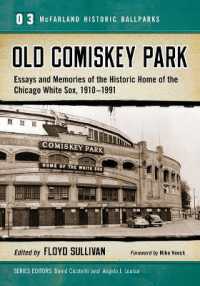- ホーム
- > 洋書
- > 英文書
- > Politics / International Relations
基本説明
Presents an empirical study of Perot's 1992 and 1996 presidential campaigns and the implications for third-party politics in the Untied States.
Full Description
Ross for Boss provides insights into the sources, continuity, and enduring importance of Ross Perot's presidential candidacies in 1992 and 1996 as a member of the Reform Party, and evaluates the impact of the Perot phenomenon on the future of both public policy and the U.S. party system. Using theoretical and historical literature on third parties and independent candidates, the contributors identify the sources of Perot's support and opposition among political activists and the mass public.
Perot's supporters are understood as "zealots of the center" who resist partisan and ideological polarization. Perot himself, the authors suggest, was a master showman, able to use classical theatrical forms to establish himself as an improbable, yet inevitable, leader of a mass movement. His support came from people whose economic interests were directly threatened by increases in the global scope of the U.S. economy, and—like other third party candidates of the twentieth century—from those without formal religious affiliations. Comparisons of the 1992 and 1996 campaigns show that the decline in support for Perot was, for the most part, uniform across geographic regions and demographic groups.
Contents
List of Figures and Tables
List of Contributors
Foreword
1 The Perot Campaigns in Theoretical Perspective
Ted G. Jelen
2 The Television Candidate: H. Ross Perot's 1992 and 1996 Presidential Races
Kenneth D. Nordin
3 A Case Study of a Third Presidential Campaign Organization:Virginians for Perot
Andrew D. Martin and Brian E. Spang
4 Attitudes Toward Government, Partisan Dispositions, and the Rise of Ross Perot
Jeffrey Koch
5 The Politics of a Bittersweet Economy: Economic Restructuring, Economic Stories, and Ross Perot in the Elections of 1992 and 1996
Solon Simmons and James Simmons
6 Structural Constraints on Perot Voting Patterns: The Effects of Religious Adherence
Christopher P. Gilbert,Timothy R. Johnson, David A. M. Peterson, and Paul A. Djupe
7 Understanding Perot's Plummet
Jeremy D. Mayer and Clyde Wilcox
8 From Ross the Boss to Jesse the Body: Did the Perot Phenomenon Spawn the Ventura Victory?
Christopher P. Gilbert and David A. M. Peterson
Index






